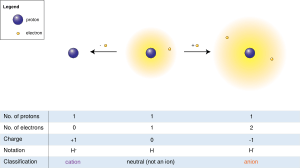Hydrogen ion facts for kids
A hydrogen ion is a tiny particle that forms when a hydrogen atom either gains or loses an electron. Think of an atom as having a central part (the nucleus) and tiny electrons orbiting around it. Hydrogen is the simplest atom, usually having just one proton in its nucleus and one electron. When it loses or gains that electron, it becomes an ion, which means it has an electric charge.
Contents
What are Positive Hydrogen Ions (Cations)?
When a hydrogen atom loses its only electron, it becomes a positively charged particle called a cation. Since it only had one proton and one electron, losing the electron leaves just the proton. That's why the simplest positive hydrogen ion is often called a proton.
There are different types of hydrogen atoms, called isotopes, which have different numbers of neutrons in their nucleus.
- Hydron is a general name for any positive hydrogen ion (H+).
- Proton is the positive ion of the most common type of hydrogen (called protium). It's written as 1H+.
- Deuteron is the positive ion of a heavier hydrogen isotope called deuterium. It's written as 2H+ or D+.
- Triton is the positive ion of the heaviest hydrogen isotope, tritium. It's written as 3H+ or T+.
When these positive hydrogen ions mix with water, they can form other ions, like the hydronium ion (H3O+), which are also considered types of hydrogen ions. In chemistry, especially when talking about acids, the term "hydrogen ions" usually refers to hydrons.
What are Negative Hydrogen Ions (Anions)?
Hydrogen atoms can also gain an extra electron. When this happens, they become negatively charged particles called anions.
- Hydride is a general name for any negative hydrogen ion (H−).
- Protide is the negative ion of the most common hydrogen isotope, protium. It's written as 1H−.
- Deuteride is the negative ion of the deuterium isotope. It's written as 2H− or D−.
- Tritide is the negative ion of the tritium isotope. It's written as 3H− or T−.
Images for kids
See also
 In Spanish: Ion hidrógeno para niños
In Spanish: Ion hidrógeno para niños



